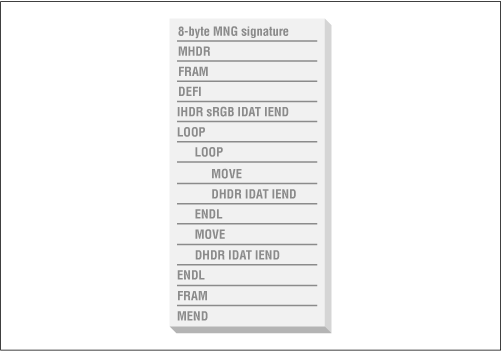| The PNG Guide is an eBook based on Greg Roelofs' book, originally published by O'Reilly. |

|

Home  Multiple-Image Network Graphics Multiple-Image Network Graphics  An Algorithmic MNG An Algorithmic MNG |
||






|
||
|
An Algorithmic MNG
The initial FRAM chunk defines the structure of the stream as a composite frame, and it is followed by a DEFI chunk that indicates the image is potentially visible. The IHDR...IEND sequence defines the first row of the image (512 pixels wide), with red changing every pixel and blue incrementing by one at the halfway point. Then the outer loop begins--we'll return to that in a moment--followed immediately by the inner loop of 255 iterations. The inner loop simply increments the green value of every pixel in the row and moves the modified line down one. The DHDR, IDAT, and IEND chunks represent this green increment; the delta pixels are simply a sequence of 512 ``0 1 0'' triples. As one might guess, they compress extremely well; the 1,536 data bytes are packed into a total of 20 zlib-compressed bytes, including six zlib header and trailer bytes. The outer loop has the task of resetting the green values to 0 again (easily accomplished by incrementing them by one more, so they roll over from 255 to 0) and of incrementing the blue values by two--recall that the first block of rows had blue = 0 on the left side and blue = 1 on the right. Thus the delta-PNG data at the bottom of the outer loop consists of 512 ``0 1 2'' triples, which compress to 23 bytes. Because the blue increments by two, this loop only needs to interate 128 times. It actually produces one extra row at the very end, but because this appears outside the frame boundary (as defined by the MHDR chunk), it is not visible.
|
||
Home  Multiple-Image Network Graphics Multiple-Image Network Graphics  An Algorithmic MNG An Algorithmic MNG |
||
Last Update: 2010-Nov-26


